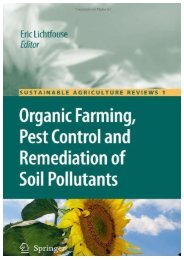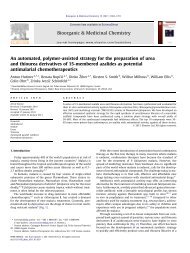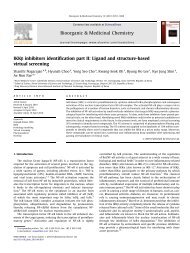- Page 2 and 3:
Echinacea The genus Echinacea © 20
- Page 4 and 5:
Echinacea The genus Echinacea Edite
- Page 6 and 7:
Contents Series Preface Preface Con
- Page 8 and 9:
Sandra C. Miller Chapter 17 Adverse
- Page 10 and 11:
Multinational pharmaceutical compan
- Page 12 and 13:
as tissue retention/distribution, b
- Page 14 and 15:
David D. Kitts Food, Nutrition and
- Page 16 and 17:
Section I The Genus Echinacea: Taxo
- Page 18 and 19:
4 Echinacea: The genus Echinacea HI
- Page 20 and 21:
6 Echinacea: The genus Echinacea ca
- Page 22 and 23:
8 Echinacea: The genus Echinacea cl
- Page 24 and 25:
10 Echinacea: The genus Echinacea A
- Page 26 and 27:
2 A Review of Preliminary Echinacea
- Page 28 and 29:
A Review of Preliminary Echinacea G
- Page 30 and 31:
A Review of Preliminary Echinacea G
- Page 32 and 33:
A Review of Preliminary Echinacea G
- Page 34 and 35:
Section II Cultivation of Genus Ech
- Page 36 and 37:
24 Echinacea: The Genus Echinacea C
- Page 38 and 39:
26 Echinacea: The Genus Echinacea F
- Page 40 and 41:
28 Echinacea: The Genus Echinacea K
- Page 42 and 43:
30 Echinacea: The genus Echinacea E
- Page 44 and 45:
32 Echinacea: The genus Echinacea T
- Page 46 and 47:
34 Echinacea: The genus Echinacea S
- Page 48 and 49:
© 2004 by CRC Press LLC TABLE 4.6
- Page 50 and 51:
38 Echinacea: The genus Echinacea o
- Page 52 and 53:
40 Echinacea: The genus Echinacea I
- Page 54 and 55:
42 Echinacea: The genus Echinacea T
- Page 56 and 57:
44 Echinacea: The genus Echinacea o
- Page 58 and 59:
46 Echinacea: The genus Echinacea 1
- Page 60 and 61:
48 Echinacea: The genus Echinacea I
- Page 62 and 63:
50 Echinacea: The genus Echinacea F
- Page 64 and 65:
52 Echinacea: The genus Echinacea S
- Page 66 and 67:
5 Introduction Nitrogen Compounds A
- Page 68 and 69: TABLE 5.1 Alkamides from Echinacea
- Page 70 and 71: Phytochemistry of the Genus Echinac
- Page 72 and 73: Phytochemistry of the Genus Echinac
- Page 74 and 75: Phytochemistry of the Genus Echinac
- Page 76 and 77: Phytochemistry of the Genus Echinac
- Page 78 and 79: Phytochemistry of the Genus Echinac
- Page 80 and 81: Phytochemistry of the Genus Echinac
- Page 82 and 83: Phytochemistry of the Genus Echinac
- Page 84 and 85: 74 Echinacea: The genus Echinacea T
- Page 86 and 87: 76 Echinacea: The genus Echinacea P
- Page 88 and 89: 78 Echinacea: The genus Echinacea I
- Page 90 and 91: 80 Echinacea: The genus Echinacea H
- Page 92 and 93: 82 Echinacea: The genus Echinacea A
- Page 94 and 95: 84 Echinacea: The genus Echinacea s
- Page 96 and 97: 86 Echinacea: The genus Echinacea B
- Page 98 and 99: 88 Echinacea: The genus Echinacea M
- Page 100 and 101: Section IV Analytical Evaluation in
- Page 102 and 103: 94 Echinacea: The genus Echinacea u
- Page 104 and 105: 96 Echinacea: The genus Echinacea o
- Page 106 and 107: 98 Echinacea: The genus Echinacea p
- Page 108 and 109: 100 Echinacea: The genus Echinacea
- Page 110 and 111: 102 Echinacea: The genus Echinacea
- Page 112 and 113: 104 Echinacea: The genus Echinacea
- Page 114 and 115: 106 Echinacea: The genus Echinacea
- Page 116 and 117: 108 Echinacea: The genus Echinacea
- Page 120 and 121: Factors Affecting Echinacea Quality
- Page 122 and 123: © 2004 by CRC Press LLC TABLE 8.1
- Page 124 and 125: Factors Affecting Echinacea Quality
- Page 126 and 127: Factors Affecting Echinacea Quality
- Page 128 and 129: Factors Affecting Echinacea Quality
- Page 130 and 131: Factors Affecting Echinacea Quality
- Page 132 and 133: Factors Affecting Echinacea Quality
- Page 134 and 135: 9 Popularity, Diversity, and Qualit
- Page 136 and 137: Popularity, Diversity, and Quality
- Page 138 and 139: Popularity, Diversity, and Quality
- Page 140 and 141: Popularity, Diversity, and Quality
- Page 142 and 143: Popularity, Diversity, and Quality
- Page 144 and 145: Popularity, Diversity, and Quality
- Page 146 and 147: Popularity, Diversity, and Quality
- Page 148 and 149: Echinacoside Echinacoside is a poly
- Page 150 and 151: TABLE 9.13 Microbiological Testing
- Page 152 and 153: Berti, M., Wilckens, R., Fischer, S
- Page 154 and 155: Kreis, W., Sussner, U. and Nusslein
- Page 156 and 157: U.S. Pharmacopeia, 2002, The Standa
- Page 158 and 159: 10 Echinacea in Vivo: A Prophylacti
- Page 160 and 161: Echinacea in Vivo: A Prophylactic A
- Page 162 and 163: Echinacea in Vivo: A Prophylactic A
- Page 164 and 165: Echinacea in Vivo: A Prophylactic A
- Page 166 and 167: Echinacea in Vivo: A Prophylactic A
- Page 168 and 169:
164 Echinacea: The genus Echinacea
- Page 170 and 171:
166 Echinacea: The genus Echinacea
- Page 172 and 173:
168 Echinacea: The genus Echinacea
- Page 174 and 175:
170 Echinacea: The genus Echinacea
- Page 176 and 177:
172 Echinacea: The genus Echinacea
- Page 178 and 179:
174 Echinacea: The genus Echinacea
- Page 180 and 181:
176 Echinacea: The genus Echinacea
- Page 182 and 183:
178 Echinacea: The genus Echinacea
- Page 184 and 185:
180 Echinacea: The genus Echinacea
- Page 186 and 187:
182 Echinacea: The genus Echinacea
- Page 188 and 189:
184 Echinacea: The genus Echinacea
- Page 190 and 191:
186 Echinacea: The genus Echinacea
- Page 192 and 193:
188 Echinacea: The genus Echinacea
- Page 194 and 195:
190 Echinacea: The genus Echinacea
- Page 196 and 197:
192 Echinacea: The genus Echinacea
- Page 198 and 199:
194 Echinacea: The genus Echinacea
- Page 200 and 201:
196 Echinacea: The genus Echinacea
- Page 202 and 203:
198 Echinacea: The genus Echinacea
- Page 204 and 205:
Section VI Clinical Assessment of t
- Page 206 and 207:
204 Echinacea: The genus Echinacea
- Page 208 and 209:
206 Echinacea: The genus Echinacea
- Page 210 and 211:
208 Echinacea: The genus Echinacea
- Page 212 and 213:
210 Echinacea: The genus Echinacea
- Page 214 and 215:
212 Echinacea: The genus Echinacea
- Page 216 and 217:
15 CONTENTS Introduction Pregnancy
- Page 218 and 219:
The use of Echinacea in Pregnancy a
- Page 220 and 221:
The use of Echinacea in Pregnancy a
- Page 222 and 223:
16 CONTENTS Two Immunoenhancers Are
- Page 224 and 225:
Two Immunoenhancers Are Not Better
- Page 226 and 227:
Two Immunoenhancers Are Not Better
- Page 228 and 229:
Two Immunoenhancers Are Not Better
- Page 230 and 231:
Two Immunoenhancers Are Not Better
- Page 232 and 233:
Two Immunoenhancers Are Not Better
- Page 234 and 235:
17 Adverse Reactions Associated wit
- Page 236 and 237:
© 2004 by CRC Press LLC TABLE 17.1
- Page 238 and 239:
Adverse Reactions Associated with E
- Page 240 and 241:
Adverse Reactions Associated with E
- Page 242 and 243:
Adverse Reactions Associated with E
- Page 244 and 245:
Adverse Reactions Associated with E
- Page 246 and 247:
18 Introduction Discussion Referenc
- Page 248 and 249:
The Efficacy of Echinacea Tea 247 (
- Page 250 and 251:
The Efficacy of Echinacea Tea 249 R
- Page 252 and 253:
The Efficacy of Echinacea Tea 251 M
- Page 254 and 255:
Veterinary Applications of Echinace
- Page 256 and 257:
Veterinary Applications of Echinace
- Page 258 and 259:
Veterinary Applications of Echinace
- Page 260 and 261:
Veterinary Applications of Echinace
- Page 262 and 263:
19 Veterinary Applications of Echin
- Page 264 and 265:
and were subjected to a complete he
- Page 266 and 267:
2002). Eight dairy heifers between
- Page 268 and 269:
and mice” (Mengs et al., 1991). T
- Page 270:
See, D.M., Broumand, N., Sahl, L. a









